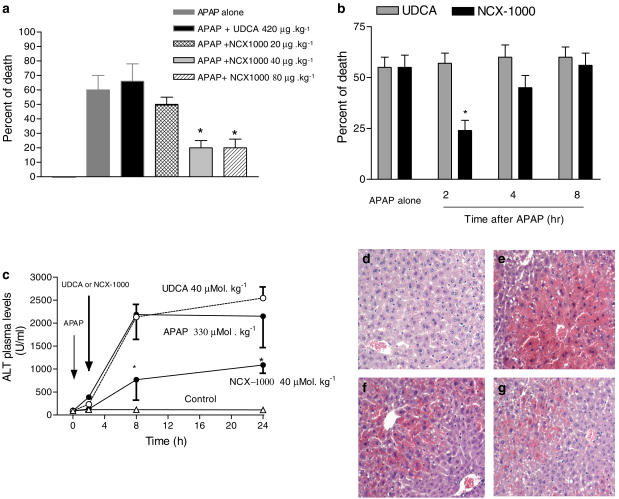Figure 1.
NCX-1000 protects against APAP-induced hepatotoxicity. Panel (a) Prevention protocol. 24-h deaths in mice coadministered with acetaminophen, 330 μmol kg−1 i.p., and UDCA, 40 μmol kg−1 i.p., or increasing doses of NCX-1000, from 20 to 80 μmol kg−1 i.p. Data are mean±s.e. of 24 mice/group. *P<0.01 versus APAP alone. Panel (b) Treatment protocol. 24-h deaths in mice administered with 40 μmol kg−1 UDCA or NCX-1000, 2, 4 or 8 h after APAP, 330 μmol kg−1 i.p. Data are mean±s.e. of 24 mice/group. *P<0.01 versus APAP alone. Panel (c) Effect of NCX-1000 on AST plasma levels. Mice were injected with APAP, 330 μmol kg−1 i.p., at time 0, and 2 h later with 40 μmol kg−1 i.p. of UDCA or NCX-1000 and killed at indicated time points. Data are mean±s.e. of eight mice/group. *P<0.01 versus APAP alone. Panels (d–g) Histopathology of APAP-induced liver damage. Hematoxylin and eosin staining, original magnification × 125. All sections were obtained from animals killed 24 h after APAP. Panel (d) Liver sections from a control mouse. Panel (e) Liver section obtained from a mouse treated with APAP, 330 μmol kg−1 i.p., showing extensive hepatocyte necrosis and apoptosis around the central lobular vein, vacuolated hepatocytes and sinusoidal space congestion. Panel (f) Liver section from a mouse treated with APAP plus UDCA, 40 μmol kg−1 i.p. 2 h after APAP, showing the same pattern of histologic lesions observed in animals treated with APAP alone. Panel (g) Liver section from a mouse treated with APAP in combination with NCX-1000, 40 μmol kg−1 i.p. 2 h after APAP, showing attenuated liver injury.

